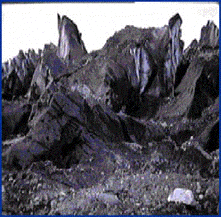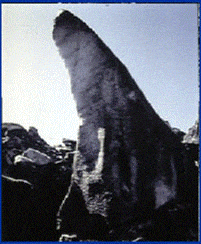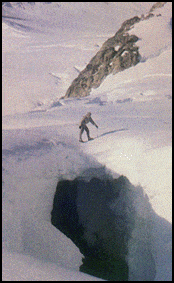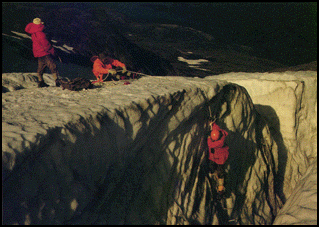Glaciers Have Their Own Warning Signs
Glaciers can be dangerous in many ways. However, as long as you keep safety in mind, visiting a glacier can be a wonderful experience.
Walking too close to a glacier can be hazardous! Often the ice will form cliffs at the terminus (the end of the glacier) or at the margins (the sides). Sometimes the ice makes towers called seracs.
Be Careful!
These cliffs and ice towers are unstable and can fall. Glaciers are always moving slowly, even though you usually can’t see them move. The movement causes stress. The stress causes cracking, which causes blocks of ice to break off and fall. Sometimes an entire serac or section of the ice front can collapse. People standing too close could be killed by falling ice.


Crevasses are dangerous
Sometimes crevasses are not visible because they are covered by surface snow. This can happen during winter snowstorms when wind causes the drifting snow to build out from the upwind side of the crevasse. Mechanical hardening of the snow, caused by wind drifting, enables the snowflakes or grains to stick together as the snow bridges out toward the downwind side of the crevasse. Finally, the crevasse is completely covered. In this way, large crevasses can be entirely hidden beneath a thin layer of snow.
Sometimes a crevasse stretching for a long way across a glacier will have a single snow bridge, which may sag into the crevasse under its own weight. Snow bridges can be strong enough to support the weight of a person, but crossing them is risky. People, snow machines (no matter how fast they are going) and, in Antarctica, even large pieces of machinery have been known to fall into covered or bridged crevasses.


Living Near Glaciers Can Be Dangerous!
In the village of Randa in Switzerland, parts of the hanging glacier below the summit have broken and fallen. Ice avalanches in the winter can cause enormous masses of snow to move and the subsequent avalanches have reached as far as the tiny village in the foreground.
Safety
A person should never walk on a glacier alone. The risk of slipping on the ice and sliding into an open crevasse, or of breaking through and falling into a hidden crevasse is too great. It would be very hard, or impossible, for a single person to get out of a crevasse without companions who have a rope and other equipment. This is especially true if the person is injured in the fall.
Glaciologists and mountaineers or glacier travelers are all extremely wary of crevasses. Before making camp on a glacier, they will use crevasse probes (a 10 meter long metal rod) to detect hidden crevasses. They also practice methods of rescuing a companion who has fallen into a crevasse, and of getting themselves out. For safety, they tie themselves together in groups of two or three using a rope about 45 meters (150 ft) long. They carry ice axes to stop themselves from sliding. If they are pulled down by one person falling into a crevasse, the ice axes help stop the fall. To keep from slipping on ice, they wear crampons, which are steel spikes attached to the bottoms of their boots.

The correct way to travel on a glacier:
- Travel in a team
- Team members may be roped together
- Have an experienced glacier traveler with your team
- Use proper equipment
Special Equipment:
- Ice Axes
- Ropes
- Crampons
- Crevasse Probes
Proper Clothing:
- Boots, waterproof and warm
- High tech materials for warm clothing, or dress in layers of clothing
- Don’t forget your handy duct tape!
Glacier Danger and Safety
Vocabulary Plus!
seracs
snow bridges
crampons
crevasse
stress
ice axe
crevasse probe
Review Questions
(some of the answers may come from the vocabulary list)
- What is a tower of ice surrounded on all sides by crevasses?
- What causes a block of ice to break off and fall?
- What do snow bridges cover on a glacier?
- Does wind drifting cause mechanical hardening in the snow?
- Should you walk over a snow bridge?
- What do glacier travelers wear on their boots so they don’t slide on the ice?
- Name two correct ways to travel on a glacier.
- Name a piece of proper clothing to wear when traveling on glaciers.
- If they go fast enough, snow machines can cross a snow bridge safely. True or False?
Brain Challenge!
What one thing would you like to do on a glacier?
Exercise: Dress Your Friend for His/Her Hiking Adventure
Your friend, Pat, is going to hike on Bering Glacier. Choose the right clothing and gear for his/her journey.
Please draw in the correct clothing.
Here’s a list of possible items. Which ones are right?
coloring book
crampons
video games
jacket
rope
gloves
bathing suit
hockey stick
blow dryer
bicycle
experienced traveler
boots
sandals
football
ice skates
camera
Project: Double Fisherman’s Knot
When groups of climbers climb across glaciers and up mountains, they often will connect to each other with ropes. This can save lives in the case of an avalanche. The trick is to make sure one person at the end of a rope is standing in a safe spot, out of an avalanches’ way, while the person at the other end of the rope crosses the dangerous slope. This way, it reduces the chance that the exposed climber will be swept away by the force of the avalanche.
A knot that’s often used to connect two ropes is called the double fisherman’s knot. Tying knots may seem tricky at first, but it’s fun! Let’s try this knot:
You’ll need two pieces of rope, about one to one-and-a-half yards long each.



